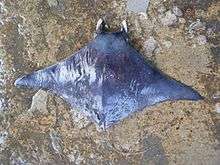Mobula kuhlii
The shortfin devil ray (Mobula kuhlii) is a species of ray in the family Mobulidae. It is endemic to the Indian Ocean and central-west Pacific Ocean. It ranges from South Africa, Mozambique, Tanzania and the Seychelles in the west to the Philippines and Indonesia in the east, and southward to the northern coast of Australia.
| Mobula kuhlii | |
|---|---|
 | |
| Scientific classification | |
| Kingdom: | |
| Phylum: | |
| Class: | |
| Order: | |
| Family: | |
| Genus: | |
| Species: | M. kuhlii |
| Binomial name | |
| Mobula kuhlii | |
| Synonyms[2] | |
| |
Description
The shortfin devil ray is a small eagle ray growing to a maximum width of 120 cm (47 in) and a weight of 30 kilograms (66 lb). It is flattened horizontally with a wide central disc and the head is short with small cephalic fins. The large pectoral fins have curved tips and the dorsal fin has a white tip. The tail is not tipped with a spine and is shorter than the body. The dorsal surface of this fish is brown and does not bear any placoid scales, and the ventral surface is white.[3][4]
Biology
The shortfin devil ray feeds on plankton and possibly also on small fish and squid. It gathers its food by swimming with its mouth open and passing the water over its gill rakers which filter out the food particles. It is an ovoviviparous fish and has the lowest rate of reproduction of any of the elasmobranchs.[1] A litter usually consists of a single pup and the gestation period is one to three years.[1]
Status
The International Union for Conservation of Nature have classified the conservation status of this species as endangered. This is because the shortfin devil ray is the subject of both targeted and bycatch inshore fisheries. It is vulnerable to over-fishing because of its low reproductive rate. Targeted fisheries occur in India, Sri Lanka and Thailand, and this ray is caught in Indonesia especially for its gill rakers.[1] These are valuable because of their use in traditional Chinese medicine. The flesh is used for human consumption, the skin is dried and deep fried, and the cartilage is used as a filler in the manufacture of shark fin soup.[5]
References
- Rigby, C.L., Barreto, R., Carlson, J., Fernando, D., Fordham, S., Francis, M.P., Jabado, R.W., Liu, K.M., Marshall, A. & Romanov, E. (2020). "Mobula kuhlii". IUCN Red List of Threatened Species. 2020: e.T161439A124485584. Retrieved 17 July 2020.CS1 maint: multiple names: authors list (link)
- Bailly, Nicolas (2014). "Mobula kuhlii (Müller & Henle, 1841)". WoRMS. World Register of Marine Species. Retrieved 2015-01-14.
- "Mobula kuhlii (Müller & Henle, 1841)". FishBase. Retrieved 2015-01-09.
- Notarbartalo-di-Sciara, G (1987). "A revisionary study of the genus Mobula Rafinesque, 1810 (Chondrichthyes: Mobulidae) with the description of a new species". Zoological Journal of the Linnean Society. 91 (1): 1–91. doi:10.1111/j.1096-3642.1987.tb01723.x.
- White, William T.; Giles, Jenny; Dharmadi, Potter; Ian C. (2006). "Data on the bycatch fishery and reproductive biology of mobulid rays (Myliobatiformes) in Indonesia". Fisheries Research. 82 (1–3): 65–73. doi:10.1016/j.fishres.2006.08.008.
